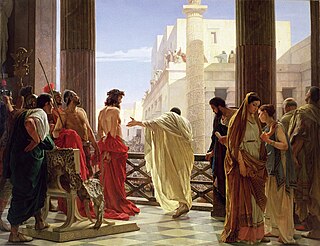
The first-century Jewish historian Flavius Josephus provides external information on some people and events found in the New Testament. The extant manuscripts of Josephus' book Antiquities of the Jews, written around AD 93–94, contain two references to Jesus of Nazareth and one reference to John the Baptist.
Abilene or simply Abila was a plain, a district in Coele-Syria, of which the chief town was Abila Lysaniou. The limits of this region are nowhere exactly defined, but it seems to have included the eastern slopes of the Anti-Lebanon range, and to have extended south and southeast of Damascus as far as the borders of Galilaea, Batanaea, and Trachonitis. According to Flavius Josephus, Abilene was a separate Iturean kingdom until 37 AD.

Pontius Pilate was the fifth governor of the Roman province of Judaea, serving under Emperor Tiberius from 26/27 to 36/37 AD. He is best known for being the official who presided over the trial of Jesus and ultimately ordered his crucifixion. Pilate's importance in Christianity is underscored by his prominent place in both the Apostles' and Nicene Creeds. Because the gospels portray Pilate as reluctant to execute Jesus, the Ethiopian Orthodox Tewahedo Church believes that Pilate became a Christian and venerates him as both a martyr and a saint, a belief which is historically shared by the Coptic Church, with a feast day on 19 or 25 June, respectively.

Josef Ben Caiaphas, known simply as Caiaphas in the New Testament, was the Jewish high priest during the years of Jesus' ministry, according to Josephus. The Gospels of Matthew, Luke and John indicate he was an organizer of the plot to kill Jesus. He famously presided over the Sanhedrin trial of Jesus. The primary sources for Caiaphas' life are the New Testament, and the writings of Josephus. The latter records he was made high priest by the Roman procurator Valerius Gratus after Simon ben Camithus had been deposed.

Theophilus was the High Priest in the Second Temple in Jerusalem from 37 to 41 CE according to Josephus's Antiquities of the Jews. He was a member of one of the wealthiest and most influential Jewish families in Iudaea Province during the 1st century. A growing but still uncommon belief points to High Priest Theophilus as the person to whom the Gospel of Luke is addressed, but Theophilus is a common enough name that there are many other possibilities for the addressee of Luke's Gospel and the Acts of the Apostles. In its favor is the fact that in Luke Theophilus is called by the title Most Excellent (kratiste), indicating he held a political office like high priest, the ethnarch under the Romans. In Acts 1:1 he does not have this honorific indicating that he no longer held an office of the Roman government. This provides an unusual identifier that eliminates other candidates for whom such a change in office was not effected.
Theophilus is the name or honorary title of the person to whom the Gospel of Luke and the Acts of the Apostles are addressed. It is thought that both works were written by the same author, and often argued that the two books were originally a single unified work. Both were written in a refined Koine Greek, and the name θεόφιλος ("Theophilos"), as it appears therein, means friend of God or (be)loved by God or loving God in the Greek language. The true identity of Theophilus is unknown, with several conjectures and traditions around an identity. In English Theophilus is also written "Theophilos", both a common name and an honorary title among the learned (academic) Romans and Jews of the era. The life of Theophilus would coincide with the writing of Luke and the author of the Acts.

The Miracle Maker sometimes subtitled The Story of Jesus, is a 1999 Welsh-Russian stop motion-animated film directed by Derek Hayes and Stanislav Sokolov.

Judaea was a Roman province from 6 to 132 AD, which incorporated the Levantine regions of Idumea, Philistia, Judea, Samaria, and Galilee, extending over parts of the former regions of the Hasmonean and Herodian kingdoms of Judea. The name Judaea was derived from the Iron Age Kingdom of Judah, that was centered predominantly in Judea.
Eleazar ben Simon was a Zealot leader during the First Jewish-Roman War who fought against the armies of Cestius Gallus, Vespasian, and Titus Flavius. From the onset of the war in 66 CE until the destruction of the temple in 70 CE, he fought vehemently against the Roman garrisons in Judea and against his fellow Jewish political opponents in order to establish an independent Jewish state at Jerusalem. Although the Jewish defeat at Jerusalem cannot be entirely attributed to Eleazar ben Simon, his inability to establish unity with John of Gischala and Simon bar Giora resulted in a bitter civil war that weakened the Jewish resistance against Rome. Eleazar ben Simon and his Zealots' radical anti-Roman policies and eradication of the moderate temple aristocracy from Jerusalem in 67 CE also prevented any peaceful agreement with Rome to avoid the death and destruction which ensued in 70 CE.
Joshua ben Gamla, also called Jesus the son of Gamala, was a Jewish high priest in about 64-65 CE. He was killed during the First Jewish–Roman War. While the Talmud refers to Joshua ben Gamla, the earlier Greek works of Josephus Flavius call him Γαμάλα μὲν υἱὸς Ἰησοῦς a semitism for: The son of Gamala, Jesus.

In the New Testament, the Sanhedrin trial of Jesus refers to the trial of Jesus before the Sanhedrin following his arrest in Jerusalem and prior to the trial before Pontius Pilate. It is an incident reported by all three Synoptic Gospels of the New Testament, while the Gospel of John refers to a preliminary inquiry before Annas. The gospel accounts vary on a number of details.

Matthew 27:2 is the second verse of the twenty-seventh chapter of the Gospel of Matthew in the New Testament. Jesus has been condemned by the Jewish Sanhedrin, and in this verse is handed over to Pontius Pilate.
Valerius Gratus was the 4th Roman Prefect of Judaea province under Tiberius from 15 to 26 CE.
Lucceius Albinus was the 6th Roman Procurator of Judea from 62 until 64 and the governor of Mauretania Tingitana from 64 until 69.
Ananus ben Ananus was a Herodian-era High Priest of Israel in Jerusalem, Judea Province. He was the High Priest who ordered the execution by stoning of James, the brother of Jesus, according to the Antiquities of the Jews of Josephus. A delegation sent by citizens upset over the perceived breach of justice met Lucceius Albinus before he reached Judea, and Albinus responded with a letter informing Ananus that it was illegal to convene the Sanhedrin without Albinus' permission and threatening to punish the priest. Ananus was therefore deposed by King Herod Agrippa II before Albinus's arrival and replaced with Jesus ben Damneus.
The procuratorial coinage of Roman Judaea was minted by the prefects and procurators of the province between AD 6 and 66 in only one denomination and size, the bronze prutah. All the coins were minted in Jerusalem.

Jesus son of Damneus was a Herodian-era High Priest of Judaea in Jerusalem, Iudaea Province.

In the canonical gospels, Pilate's court refers to the trial of Jesus in praetorium before Pontius Pilate, preceded by the Sanhedrin Trial. In the Gospel of Luke, Pilate finds that Jesus, being from Galilee, belonged to Herod Antipas' jurisdiction, and so he decides to send Jesus to Herod. After questioning Jesus and receiving very few replies, Herod sees Jesus as no threat and returns him to Pilate.
Simon ben Camithus was a 1st-century High Priest of Israel, who was given the office by the Roman procurator Valerius Gratus and held the office from 17AD to 18AD. Very little is known of him, however he is briefly mentioned in the Talmud as one of the seven sons of Kimchit to serve as high priest, and according to Josephus was succeeded as High Priest by Joseph Caiaphas.








